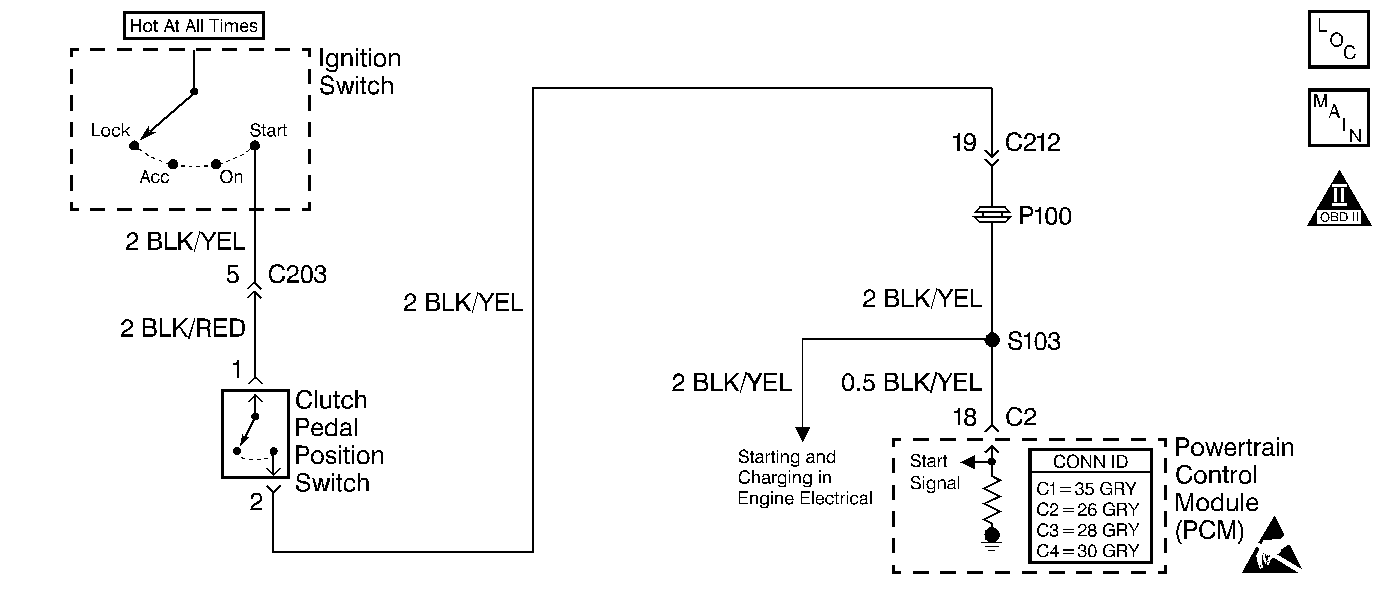
Circuit Description
While the engine is being cranked, the battery voltage is applied to the powertrain control module (PCM). The starter signal is mainly used to increase the fuel injection volume for the starting injection control. This signal is sent from the transmission range switch (automatic transmission) or the clutch pedal position (CPP) switch. If this signal is not detected during ignition, the PCM will still allow the engine to start.
Condition for Running the DTC
The engine is being cranked.
Conditions for Setting the DTC
| • | No signal to the PCM with the starter engaged. |
| • | Low voltage at the PCM while the engine is cranking. |
| • | High voltage at the PCM after the engine has started. |
Action Taken When the DTC Sets
| • | The malfunction indicator lamp (MIL) will illuminate after two consecutive ignition cycles in which the diagnostic runs with the fault active. |
| • | The PCM will record the operating conditions at the time the diagnostic fails. This information will be stored in the Freeze Frame buffer. |
Conditions for Clearing the MIL/DTC
| • | The MIL will turn OFF after three consecutive drive cycles without a fault present. |
| • | A DTC will clear after 40 consecutive warm-up cycles without a fault. |
| • | The DTCs can be cleared by using a scan tool or by disconnecting the PCM battery feed. |
Diagnostic Aids
An intermittent malfunction may be caused by a fault in the starter signal sensor circuit. Inspect the wiring harness and components for any of the following conditions:
| • | Backed out terminals |
| • | Improper mating of terminals |
| • | Broken electrical connector locks |
| • | Improperly formed or damaged terminals |
| • | Faulty terminal to wire connections |
| • | Physical damage to the wiring harness |
| • | A broken wire inside the insulation |
| • | Corrosion of electrical connections, splices, or terminals |
If the DTC P1500 is intermittent, driving the vehicle under the following conditions can verify whether the fault is present. Perform the scan tool Clear DTC Information function. Road test the vehicle while monitoring the DTC P1500 diagnostic on the scan tool under the Not Ran Since Code Cleared selection in the DTC Information menu. If a DTC P1500 appears in the Not Ran Since Code Cleared list, the P1500 diagnostic has not yet run. When the DTC P1500 does not appear in the Not Ran Since Code Cleared list, the P1500 diagnostic has run. If the MIL is NOT ILLUMINATED, and there is no PENDING DTC Status in DTC Information, the P1500 diagnostic has passed. DTCs MUST BE CLEARED in order to view the CURRENT STATUS of the Not Ran Since Code Cleared list. DO NOT FORGET that the Not Ran Since Code Cleared list only indicates that the test has run, not whether the test passed or failed. The DTC Information screen must be checked for CURRENT or PENDING status, in order to determine the outcome of the diagnostic test involved.
If a DTC P1500 cannot be duplicated, the information included in the Freeze Frame data can be useful in determining vehicle operating conditions when the DTC was first set.
Test Description
The numbers below refer to the step numbers in the diagnostic table.
-
The Powertrain (OBD) System Check prompts the technician to complete some basic checks and store the Freeze Frame data on the scan tool if applicable. This creates an electronic copy of the data taken when the fault occurred. The information is then stored in the scan tool for later reference.
-
This step determines if a fault is present.
-
This step checks for the correct voltage on the crank signal circuit. While the engine is cranking, the PCM crank signal terminal should have a voltage reading of 6 to 12 volts. After the engine is started, the PCM crank signal terminal should have a voltage reading of 0 volts.
Step | Action | Value(s) | Yes | No |
|---|---|---|---|---|
Did you perform the Powertrain On-Board Diagnostic (OBD) System Check? | -- | |||
Is DTC P1500 set? | -- | Go to Diagnostic Aids | ||
Was the start signal circuit voltage at the first specified value with the ignition ON, and within the second specified value while cranking the engine? | 0 volts 6 to 12 volts | |||
4 | Repair the open or the short in the crank signal circuit between the PCM and the clutch pedal position (CPP) switch. Refer to Wiring Repairs in Wiring Systems. Is the action complete? | -- | -- | |
5 |
Was a repair necessary? | -- | ||
6 | Replace the PCM. Refer to Powertrain Control Module Replacement/Programming . Is the action complete? | -- | -- | |
7 |
Are any DTCs displayed on the scan tool? | -- | System OK |
